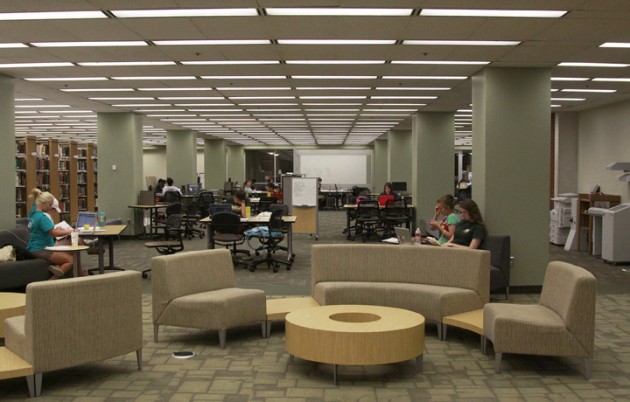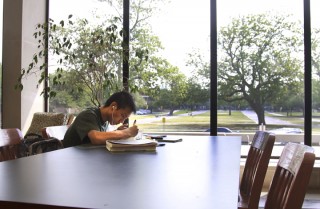Lab experiment deems library basement best place to study

Matt Hellman | Lariat Photographer

Matt Hellman | Lariat Photographer
By Ali Croom
Contributor
College is full of distractions.
Noisy neighbors, blaring televisions and the roommate’s barking dog are enough to make the ideal study environment hard to come by.
To escape the distracting noises of home, students are retreating to campus to find focus. But study areas seem to be different for every student.
“My favorite place to study is the Armstrong Browning Library. It’s peaceful and beautiful. It doesn’t have great hours, but it makes you feel smarter just sitting there,” Houston sophomore Kaitlin Lolie said.
Baylor libraries are some of the most popular places to study. Some students have started referring to Moody Memorial Library as “Club Moody,” since so many students study there.
“I enjoy studying on the second floor of Moody. It isn’t the silent part of the library, but it also isn’t the most social area, either. I have a spot where I can see Pat Neff Hall, and it reminds me of why I’m here,” Gonzales freshman Alexis Zumwalt said.
Some students use the libraries for inspiration like Zumwalt. For others, the libraries serve a different purpose.
“I go to the library to get away from the noise in my house and to focus on my homework. My house is too distracting to get anything done,” Waco junior Austin Childress said.
But not all students prefer the libraries.
Other locations where studious students flock include the McLane Student Life Center, the Baylor Sciences Building and the Bill Daniel Student Center.
“I like studying in the BSB’s side rooms. It’s quiet, and you have all the necessary tools to study. I also like the view,” Carrollton junior Nathan Rogers said.
Choosing the best place to study isn’t just a matter of personal preference. It’s a science.
In the Environmental Analysis course, students learn about the hazards of sound pollution. According to the course’s lab manual, repeated exposure to loud noises subject one to hearing loss. Noise exposure also carries other health risks, such as increased blood pressure, ringing in the ears, a disturbance of sleeping patterns — and even difficulty in communication.
For this specific lab conducted in the spring, students used a sound meter to measure sound levels at different spots on campus.
All sound is measured in decibels, which indicates the force sound travels through a medium — in this case, air. According to a lab done March 21 by lab section five, the quietest place to study on campus was the basement computer lab in Moody Library. It had the lowest noise score at 63 decibels. Also in the lower scores were the Bobo Spiritual Life Center study area, the café in the Bill Daniel Student Center and the Baylor Sciences Building atrium. Areas with the highest noise levels included the McLane Student Life Center exercise room, the library café Java City and the Bill Daniel Student Center television room. However, the Baylor Energy Complex won out on noise with 87.9 decibels.
“The students generally found that the farther you could get from I-35, the quieter it was for outdoor sites,” Doug Nesmith, professor of environmental science, said.
Baylor remains ear-safe, though. In order to achieve potential hearing damage, the decibels must reach a level of 110. According to the American Speech-Language-Hearing Association, nearly 10 million Americans are exposed to hearing loss from noise exposure. One of the main causes of this is MP3 players. These devices can reach 115 decibels. Experts recommend no more than 15 minutes of listening at this level in order to prevent permanent damage.


